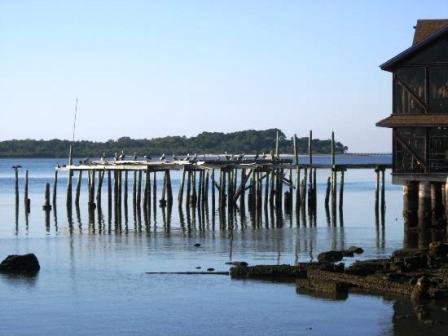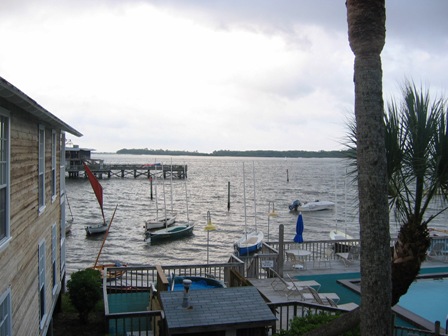Discover Florida Nature
It's time to explore the natural Florida


|
|
|
|
|
 Cedar
Key is one of the oldest ports in the state, and when Florida's first
railroad connected it to the east coast, it became a major supplier of
seafood and timber products to the northeast. Today it has become a
haven for artists and writers who find the unspoiled environment
inspirational to their work. Many people visit each year to walk the
historic streets browse the shops and galleries, explore the back bayous
and enjoy the world-famous restaurants featuring seafood fresh from
local waters. Annually, thousands of visitors come to enjoy the Old
Florida Celebration of the Arts in April, the Fourth of July Celebration
and the October Seafood Festival. Cedar
Key is one of the oldest ports in the state, and when Florida's first
railroad connected it to the east coast, it became a major supplier of
seafood and timber products to the northeast. Today it has become a
haven for artists and writers who find the unspoiled environment
inspirational to their work. Many people visit each year to walk the
historic streets browse the shops and galleries, explore the back bayous
and enjoy the world-famous restaurants featuring seafood fresh from
local waters. Annually, thousands of visitors come to enjoy the Old
Florida Celebration of the Arts in April, the Fourth of July Celebration
and the October Seafood Festival.In addition to excellent fishing, bird watching and nearby nature trails, guides are available to take parties for off-shore trips to the outer islands. A public marina with boat docking is available. The Cedar Key Museum State Park contains exhibits that depict its colorful history during the 19th century, when Cedar Key was a thriving port city and railroad connection. Part of the collection has sea shells and Indian artifacts collected by Saint Clair Whitman, the founder of the first museum in Cedar Key. Whitman's house is located at the park and has been restored to reflect life in the 1920s. A short nature trail gives visitors the opportunity to see wildlife and birds, as well as native vegetation. Small gray squirrels, doves, mockingbirds, blue jays, woodpeckers, and green tree frogs can be seen on the museum grounds and along the walking trail.  Wading
birds, shorebirds, fishes,
manatees,
bald eagles, crabs, and even
reptiles are some of the species of wildlife that find suitable habitat
on the islands and marshes that make-up Cedar Keys National Wildlife
Refuge. The Refuge consists of 13 islands ranging in size from 1 to 120
acres, totaling 762 acres. Ancient Indian cultures once used these
off-shore islands as camps, later creating living areas – where food
from the Gulf was plentiful and readily available. In more recent
history, the famous Faber Pencil Mill was located on Atsena Otie Key
where its remains can be seen today. An historic lighthouse, now leased
by the University of Florida as a Marine Science Lab, sits atop the
Pleistecene dune relic, Seahorse Key. Their goal is to conduct important
research while at the same time educating future conservation leaders
about the importance of this unique ecosystem. Wading
birds, shorebirds, fishes,
manatees,
bald eagles, crabs, and even
reptiles are some of the species of wildlife that find suitable habitat
on the islands and marshes that make-up Cedar Keys National Wildlife
Refuge. The Refuge consists of 13 islands ranging in size from 1 to 120
acres, totaling 762 acres. Ancient Indian cultures once used these
off-shore islands as camps, later creating living areas – where food
from the Gulf was plentiful and readily available. In more recent
history, the famous Faber Pencil Mill was located on Atsena Otie Key
where its remains can be seen today. An historic lighthouse, now leased
by the University of Florida as a Marine Science Lab, sits atop the
Pleistecene dune relic, Seahorse Key. Their goal is to conduct important
research while at the same time educating future conservation leaders
about the importance of this unique ecosystem. At the Cedar Key Scrub State Reserve salt marshes on the Gulf of Mexico give way to a succession of swamps, hardwood forests, pine flatwoods, and scrub, providing splendid opportunities for nature study and wildlife observation. The scrub is dominated by species such as sand live oak, myrtle oak, and Chapman's oak, along with rusty lyonia, and saw palmetto. Hikers and off-road bicyclists who want to experience a mosaic of Florida habitats will find it on the miles of trails that wind through the park. The shallow waters and numerous creeks near the salt marshes are ideal for canoeing and kayaking. Rental canoes and kayaks are available in the city of Cedar Key. The park is located on SR 24, six miles east of Cedar Key, and has a picnic shelter, tables, and grills. The Shell Mound Unit of Lower Suwannee National Wildlife Refuge is adjacent to Cedar Keys National Wildlife Refuge. This ancient feature was initially created by Archaic cultures and completed by Woodland period cultures. Its height was reached by the discarding the shells of their food source - oysters, clams, and other mullosks. over a 6,000 time span. Once used as a source of materials for road construction (prior to Refuge ownership) the mound is now protected from all but foot traffic. |
|
|
Cedar Key Florida
Cedar Key is one of the oldest ports in Florida. Today it has become a haven for artists and writers who find the unspoiled environment inspirational to their work. Floridian nature abounds with wading birds, shorebirds, fishes, manatees, bald eagles, crabs, and even reptiles.
Cedar Keys National Wildlife Refuge consists of 13 islands ranging in size from 1 to 120 acres, totaling 762 acres. Ancient Indian cultures once used these off-shore islands as camps. Enjoying wildlife in a peaceful environment, eating at the famous seafood restaurants, or watching the beautiful sunsets are all reasons Cedar Key is truly Floridian nature at its best!
Written by: Floridian Nature
Cedar Key
Date published: 10/22/2013
4 / 5 stars
|
|